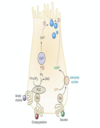Digestion of CHOs Flashcards
(72 cards)
What are CHOs digested to
Simple sugars

Proteins are hydrolysed to
Di & tripeptides and free AAs

TAG metabolism

Primary function of salivary glands
Production of fluid & digestive enzymes for homogenisation, lubrication & digestion of CHO (amylase) and lipid (lingual lipases)
Primary function of stomach
Secretion of HCl and proteases to initiate hydrolysis of proteins
Primary function of pancreas
Secretion of HCO3-, proteases and lipases to continue digestion of proteins/lipids and amylase to continue digesting starch
Primary function of liver/gall bladder
Secretion and storage of bile acids for release to SI
Primary function of SI
Final intraluminal digestion of food, digestion of CHO dimers and specific absorptive pathways for digested material
Primary function of LI
Absorption of fluid and electrolytes and products of bacterial action in the colon
Names and functions of the 3 pairs of salivary glands
- Parotid
- Submandibular
- Sublingual
alpha-amylase
-> lubrication
Function of exocrine liver
Produces bile - important for fat digestion & absorption
ALSO excretion of waste metabolites and drugs
Function of saliva
Lubrication - enables chewing & swallowing
Functions of amylase
Major digestive enzyme
- Hydrolyses alpha 1,4 glycosidic linkages in starch
- Continues even after food has reached the stomach
- Gastric juice inactivates it but not immediately
- Starch in potatoes or bread may be 75% digested before inactivation of enzyme
What are the other enzymes in saliva
- Lysozyme (beta 1,4 glycosidic bonds in bacterial cell wall polysaccharide peptidoglycan)
- Sialoperoxidase (bacteriostatic)
- Lingual lipase
- Ribonuclease
- Deoxyribonuclease
Function of stomach
Store ingested food and regulate release into duodenum
- Chyme
- exocrine secretions - gastric juices
- paracrine secretion - histamine which stimulates gastric secretion
- endocrine secretion - hormone gastrin
- Stimulates gastric motility & acid secretion
- Acts on intestines, pancreas and liver
How much gastric juice is secreted a day
2 litres
What is the intrinsic factor of gastric juice important for
Vit B12
- absence leads to pernicious anemia
What is peptin responsible for
20% protein digestion
Endopeptidase degrades…
Proteins -> peptides
What is pepsin formed from
Inactive precursor pepsinogen
What is the optimal pH of pepsin
- 5
- implicated in acid-induced ulceration
What lines the stomach to protect it from damage by acid and pepsin
Mucus
Endocrine function of pancreas
Insulin and glucagon
Exocrine function of pancreas
Secrete pancreatic juice via pancreatic duct












